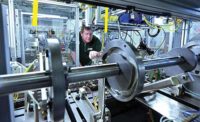Productivity growth in manufacturing is stuck. Despite improvements in equipment, software and management approaches, annual labor productivity growth in the U.S. was around 0.7 percent between 2007 and 2018. In fact, there’s been zero net average productivity growth during the past five years.
Industry 4.0 promises to reignite productivity growth in manufacturing via connected machines, people, data and value chains. That was the conclusion of a 2019 study conducted by Deloitte and the Manufacturer’s Alliance for Productivity and Innovation (MAPI).
Deloitte and MAPI launched the study to quantify the impact of smart factories on productivity and manufacturing’s contribution to U.S. GDP through 2030. The study included an online survey of more than 600 manufacturing executives. It also included interviews with more than a dozen executives; focus group discussions with finance and operations leaders at manufacturers; and analysis of secondary data and economic projections from Deloitte’s global economic team.
The study revealed five major findings:
Every manufacturer—whether already running smart or yet to invest in such technologies—can harvest business value from smart factory initiatives.
Smart factory initiatives accelerate business value creation. Companies report gains of 10 to 12 percent in manufacturing output, factory utilization and labor productivity after investing in smart factory initiatives.
There is a direct connection between smart factory initiatives and business value.
While there are operational and financial risks, they are outnumbered by the smart factory’s value contribution. Also, most risks can be mitigated through rational stakeholder selection, an efficient change-management strategy, measurable proof-of-concepts, and incremental investments.
Early adopters—identified as Trailblazers in the study—are outperforming their competition with smart factory initiatives. Trailblazers report average three-year gains of 10 percent for factory output, capacity utilization and labor productivity. What’s more, these companies expect labor productivity to improve to 12 percent by 2022.
A closer look at labor productivity trends indicates that smart factory initiatives will likely enable U.S. manufacturers to experience triple the labor productivity growth rate during the next decade (2019-2030) compared to last decade (2007-2018). Using the study data and Deloitte’s forecasting model, the researchers determined that labor productivity will likely grow at a compound annual rate of 2.3 percent from 2025 to 2030, closer to the level last seen in the 1990s.
The study identified 12 common categories of use cases—each a combination of advanced technologies targeted at specific business and production processes in smart factories. The researchers’ analysis reveals that most manufacturers actively investing in smart factory technology have an average of nine use cases in action.
Read the study for yourself here: https://tinyurl.com/ut2krms.




